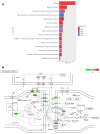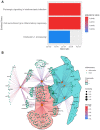A Hybrid Machine Learning and Network Analysis Approach Reveals Two Parkinson's Disease Subtypes from 115 RNA-Seq Post-Mortem Brain Samples
- PMID: 35269707
- PMCID: PMC8910747
- DOI: 10.3390/ijms23052557
A Hybrid Machine Learning and Network Analysis Approach Reveals Two Parkinson's Disease Subtypes from 115 RNA-Seq Post-Mortem Brain Samples
Abstract
Precision medicine emphasizes fine-grained diagnostics, taking individual variability into account to enhance treatment effectiveness. Parkinson’s disease (PD) heterogeneity among individuals proves the existence of disease subtypes, so subgrouping patients is vital for better understanding disease mechanisms and designing precise treatment. The purpose of this study was to identify PD subtypes using RNA-Seq data in a combined pipeline including unsupervised machine learning, bioinformatics, and network analysis. Two hundred and ten post mortem brain RNA-Seq samples from PD (n = 115) and normal controls (NCs, n = 95) were obtained with systematic data retrieval following PRISMA statements and a fully data-driven clustering pipeline was performed to identify PD subtypes. Bioinformatics and network analyses were performed to characterize the disease mechanisms of the identified PD subtypes and to identify target genes for drug repurposing. Two PD clusters were identified and 42 DEGs were found (p adjusted ≤ 0.01). PD clusters had significantly different gene network structures (p < 0.0001) and phenotype-specific disease mechanisms, highlighting the differential involvement of the Wnt/β-catenin pathway regulating adult neurogenesis. NEUROD1 was identified as a key regulator of gene networks and ISX9 and PD98059 were identified as NEUROD1-interacting compounds with disease-modifying potential, reducing the effects of dopaminergic neurodegeneration. This hybrid data analysis approach could enable precision medicine applications by providing insights for the identification and characterization of pathological subtypes. This workflow has proven useful on PD brain RNA-Seq, but its application to other neurodegenerative diseases is encouraged.
Keywords: Parkinson’s disease; RNA-seq; data science; genomic data science; machine learning; network analysis; precision medicine; subtyping.
Conflict of interest statement
The authors declare no conflict of interest.
Figures







References
-
- Deuschl G., Beghi E., Fazekas F., Varga T., Christoforidi K.A., Sipido E., Bassetti C.L., Vos T., Feigin V.L. The Burden of Neurological Diseases in Europe: An Analysis for the Global Burden of Disease Study 2017. Lancet Public Health. 2020;5:e551–e567. doi: 10.1016/S2468-2667(20)30190-0. - DOI - PubMed
-
- Dorsey E.R., Elbaz A., Nichols E., Abd-Allah F., Abdelalim A., Adsuar J.C., Ansha M.G., Brayne C., Choi J.-Y.J., Collado-Mateo D., et al. Global, Regional, and National Burden of Parkinson’s Disease, 1990–2016: A Systematic Analysis for the Global Burden of Disease Study 2016. Lancet Neurol. 2018;17:939–953. doi: 10.1016/S1474-4422(18)30295-3. - DOI - PMC - PubMed
MeSH terms
LinkOut - more resources
Full Text Sources
Medical

